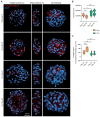Adipose Stromal Cell Spheroids for Cartilage Repair: A Promising Tool for Unveiling the Critical Maturation Point
- PMID: 37892912
- PMCID: PMC10603958
- DOI: 10.3390/bioengineering10101182
Adipose Stromal Cell Spheroids for Cartilage Repair: A Promising Tool for Unveiling the Critical Maturation Point
Abstract
Articular cartilage lacks intrinsic regenerative capabilities, and the current treatments fail to regenerate damaged tissue and lead only to temporary pain relief. These limitations have prompted the development of tissue engineering approaches, including 3D culture systems. Thanks to their regenerative properties and capacity to recapitulate embryonic processes, spheroids obtained from mesenchymal stromal cells are increasingly studied as building blocks to obtain functional tissues. The aim of this study was to investigate the capacity of adipose stromal cells to assemble in spheroids and differentiate toward chondrogenic lineage from the perspective of cartilage repair. Spheroids were generated by two different methods (3D chips vs. Ultra-Low Attachment plates), differentiated towards chondrogenic lineage, and their properties were investigated using molecular biology analyses, biophysical measurement of mass density, weight, and size of spheroids, and confocal imaging. Overall, spheroids showed the ability to differentiate by expressing specific cartilaginous markers that correlate with their mass density, defining a critical point at which they start to mature. Considering the spheroid generation method, this pilot study suggested that spheroids obtained with chips are a promising tool for the generation of cartilage organoids that could be used for preclinical/clinical approaches, including personalized therapy.
Keywords: adipose stromal cells; chondrogenesis; deep imaging; mass density; spheroids.
Conflict of interest statement
The authors of Affiliation 1 (A.S., D.G. and S.P.) are employed by CellDynamics iSRL company. Author M.L. is employed by abc biopply. This does not alter the authors adherence to Bioengineering policies on sharing data and materials. The remaining authors (C.C., S.S., B.G., G.F. and L.D.) declare that the research was conducted in the absence of any commercial or financial relationships that could be construed as a potential conflict of interest.
Figures





Similar articles
-
Pre-culture of human mesenchymal stromal cells in spheroids facilitates chondrogenesis at a low total cell count upon embedding in biomaterials to generate cartilage microtissues.Acta Biomater. 2022 Apr 15;143:253-265. doi: 10.1016/j.actbio.2022.02.038. Epub 2022 Mar 1. Acta Biomater. 2022. PMID: 35240315
-
Cartilage and bone tissue engineering using adipose stromal/stem cells spheroids as building blocks.World J Stem Cells. 2020 Feb 26;12(2):110-122. doi: 10.4252/wjsc.v12.i2.110. World J Stem Cells. 2020. PMID: 32184936 Free PMC article. Review.
-
Scaffolded spheroids as building blocks for bottom-up cartilage tissue engineering show enhanced bioassembly dynamics.Acta Biomater. 2024 Jan 15;174:163-176. doi: 10.1016/j.actbio.2023.12.001. Epub 2023 Dec 7. Acta Biomater. 2024. PMID: 38065247
-
Human Adipose-Derived Mesenchymal Stromal/Stem Cell Spheroids Possess High Adipogenic Capacity and Acquire an Adipose Tissue-like Extracellular Matrix Pattern.Tissue Eng Part A. 2020 Aug;26(15-16):915-926. doi: 10.1089/ten.TEA.2019.0206. Epub 2020 Apr 9. Tissue Eng Part A. 2020. PMID: 32070231
-
Trends in Articular Cartilage Tissue Engineering: 3D Mesenchymal Stem Cell Sheets as Candidates for Engineered Hyaline-Like Cartilage.Cells. 2021 Mar 13;10(3):643. doi: 10.3390/cells10030643. Cells. 2021. PMID: 33805764 Free PMC article. Review.
Cited by
-
Lesson on obesity and anatomy of adipose tissue: new models of study in the era of clinical and translational research.J Transl Med. 2024 Aug 14;22(1):764. doi: 10.1186/s12967-024-05547-3. J Transl Med. 2024. PMID: 39143643 Free PMC article. Review.
-
Establishment and characterization of an inflammatory cartilaginous organoids model for organoid transplantation study.J Orthop Translat. 2025 May 10;52:376-386. doi: 10.1016/j.jot.2025.05.002. eCollection 2025 May. J Orthop Translat. 2025. PMID: 40476067 Free PMC article.
-
Cartilage-Specific Gene Expression and Extracellular Matrix Deposition in the Course of Mesenchymal Stromal Cell Chondrogenic Differentiation in 3D Spheroid Culture.Int J Mol Sci. 2024 May 23;25(11):5695. doi: 10.3390/ijms25115695. Int J Mol Sci. 2024. PMID: 38891883 Free PMC article.
-
CRIPTO's multifaceted role in driving aggressive prostate cancer unveiled by in vivo, organoid, and patient data.Oncogene. 2025 Mar;44(7):462-475. doi: 10.1038/s41388-024-03230-x. Epub 2024 Nov 26. Oncogene. 2025. PMID: 39592836 Free PMC article.
References
-
- Quinn T.M., Häuselmann H.-J., Shintani N., Hunziker E.B. Cell and Matrix Morphology in Articular Cartilage from Adult Human Knee and Ankle Joints Suggests Depth-Associated Adaptations to Biomechanical and Anatomical Roles. Osteoarthr. Cartil. 2013;21:1904–1912. doi: 10.1016/j.joca.2013.09.011. - DOI - PubMed
Grants and funding
LinkOut - more resources
Full Text Sources

